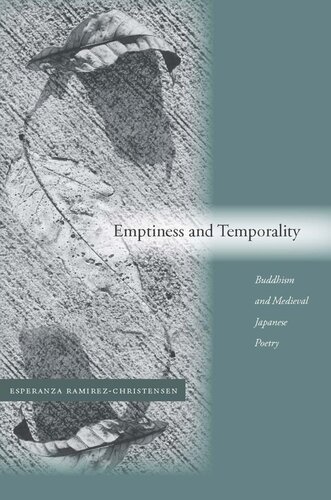

Most ebook files are in PDF format, so you can easily read them using various software such as Foxit Reader or directly on the Google Chrome browser.
Some ebook files are released by publishers in other formats such as .awz, .mobi, .epub, .fb2, etc. You may need to install specific software to read these formats on mobile/PC, such as Calibre.
Please read the tutorial at this link: https://ebookbell.com/faq
We offer FREE conversion to the popular formats you request; however, this may take some time. Therefore, right after payment, please email us, and we will try to provide the service as quickly as possible.
For some exceptional file formats or broken links (if any), please refrain from opening any disputes. Instead, email us first, and we will try to assist within a maximum of 6 hours.
EbookBell Team

4.7
46 reviewsEmptiness and Temporality is an account of classical Japanese poetics based, for the first time, on the two concepts of emptiness (J.kū) and temporality (mujō) that ground the medieval practice and understanding of poetry. It clarifies the unique structure of the collective poetic genre called renga (linked poetry) by analyzing Shinkei's writings, particularly Sasamegoto. This book engages contemporary Western theory, especially Derrida's concepts of différance and deconstruction, to illuminate the progressive displacement that constitutes the dynamic poetry of the renga link as the sequence moves from verse 1 to 100. It also draws on phenomenology, Heidegger's Being and Time, Bakhtin's notion of the dialogical, Gadamer's Truth and Method, hermeneutics, and the concept of translation to delve into philosophical issues of language, mind, and the creative process. Furthermore, the book traces the development of the Japanese sense of the sublime and ineffable (yūgen and its variants) from the identification, by earlier waka poets like Shunzei and Teika, of their artistic practice with Buddhist meditation (Zen or shikan), and of superior poetry as the ecstatic figuration of the Dharma realm. Emptiness and Temporality constitutes a radically new definition of Japanese poetry from the medieval period onward as a symbolist poetry, a figuration of the sacred rather than a representation of nature, and reveals how the spiritual or moral dimension is essential to an understanding of traditional Japanese aesthetic ideals and practices, such as Nô performance, calligraphy, and black-ink painting.